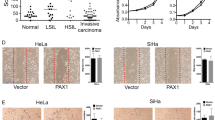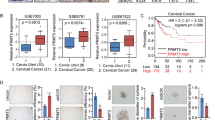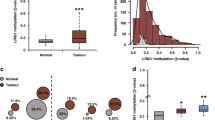Abstract
Epigenetic modifications are a driving force in carcinogenesis. However, their role in cancer metastasis remains poorly understood. The present study investigated the role of DNA methylation in the cervical cancer metastasis. Here, we report evidence of the overexpression of DNA methyltransferases 3B (DNMT3B) in invasive cervical cancer and of the inhibition of metastasis by DNMT3B interference. Using methyl-DNA immunoprecipitation coupled with microarray analysis, we found that the protein tyrosine phosphatase receptor type R (PTPRR) was silenced through DNMT3B-mediated methylation in the cervical cancer. PTPRR inhibited p44/42 MAPK signaling, the expression of the transcription factor AP1, human papillomavirus (HPV) oncogenes E6/E7 and DNMTs. The methylation status of PTPRR increased in cervical scrapings (n=358) in accordance with disease severity, especially in invasive cancer. Methylation of the PTPRR promoter has an important role in the metastasis and may be a biomarker of invasive cervical cancer.
This is a preview of subscription content, access via your institution
Access options
Subscribe to this journal
Receive 50 print issues and online access
$259.00 per year
only $5.18 per issue
Buy this article
- Purchase on Springer Link
- Instant access to full article PDF
Prices may be subject to local taxes which are calculated during checkout







Similar content being viewed by others
References
WHO/ICO Information Centre on HPV and Cervical Cancer. Human Papillomavirus and Related Cancers in World. Summary Report 2010 2010. 2010/11/15.
zur Hausen H . Cervical carcinoma and human papillomavirus: on the road to preventing a major human cancer. J Natl Cancer Inst 2001; 93: 252–253.
Moody CA, Laimins LA . Human papillomavirus oncoproteins: pathways to transformation. Nat Rev Cancer 2010; 10: 550–560.
Ostor AG . Natural history of cervical intraepithelial neoplasia: a critical review. Int J Gynecol Pathol 1993; 12: 186–192.
Nguyen DX, Massague J . Genetic determinants of cancer metastasis. Nat Rev Genet 2007; 8: 341–352.
Jaenisch R, Bird A . Epigenetic regulation of gene expression: how the genome integrates intrinsic and environmental signals. Nat Genet 2003; 33 (Suppl): 245–254.
Esteller M . Epigenetics in cancer. N Engl J Med 2008; 358: 1148–1159.
Rodenhiser DI . Epigenetic contributions to cancer metastasis. Clin Exp Metastasis 2009; 26: 5–18.
Sharma S, Kelly TK, Jones PA . Epigenetics in cancer. Carcinogenesis 2010; 31: 27–36.
Paschos K, Allday MJ . Epigenetic reprogramming of host genes in viral and microbial pathogenesis. Trends Microbiol 2010; 18: 439–447.
Woodman CB, Collins SI, Young LS . The natural history of cervical HPV infection: unresolved issues. Nat Rev Cancer 2007; 7: 11–22.
Chung MT, Sytwu HK, Yan MD, Shih YL, Chang CC, Yu MH et al. Promoter methylation of SFRPs gene family in cervical cancer. Gynecol Oncol 2009; 112: 301–306.
Liu CY, Chao TK, Su PH, Lee HY, Shih YL, Su HY et al. Characterization of LMX-1A as a metastasis suppressor in cervical cancer. J Pathol 2009; 219: 222–231.
Lin YW, Chung MT, Lai HC, De Yan M, Shih YL, Chang CC et al. Methylation analysis of SFRP genes family in cervical adenocarcinoma. J Cancer Res Clin Oncol 2009; 135: 1665–1674.
Lai HC, Lin YW, Huang RL, Chung MT, Wang HC, Liao YP et al. Quantitative DNA methylation analysis detects cervical intraepithelial neoplasms type 3 and worse. Cancer 2010; Jun: 8.
Wentzensen N, Sherman ME, Schiffman M, Wang SS . Utility of methylation markers in cervical cancer early detection: appraisal of the state-of-the-science. Gynecol Oncol 2009; 112: 293–299.
Lai HC, Lin YW, Huang TH, Yan P, Huang RL, Wang HC et al. Identification of novel DNA methylation markers in cervical cancer. Int J Cancer 2008; 123: 161–167.
Chung MT, Lai HC, Sytwu HK, Yan MD, Shih YL, Chang CC et al. SFRP1 and SFRP2 suppress the transformation and invasion abilities of cervical cancer cells through Wnt signal pathway. Gynecol Oncol 2009; 112: 646–653.
Wilting SM, Snijders PJ, Meijer GA, Ylstra B, van den Ijssel PR, Snijders AM et al. Increased gene copy numbers at chromosome 20q are frequent in both squamous cell carcinomas and adenocarcinomas of the cervix. J Pathol 2006; 209: 220–230.
Talora C, Sgroi DC, Crum CP, Dotto GP . Specific down-modulation of Notch1 signaling in cervical cancer cells is required for sustained HPV-E6/E7 expression and late steps of malignant transformation. Genes Dev 2002; 16: 2252–2263.
Lichtig H, Gilboa DA, Jackman A, Gonen P, Levav-Cohen Y, Haupt Y et al. HPV16 E6 augments Wnt signaling in an E6AP-dependent manner. Virology 2010; 396: 47–58.
Gu W, Yeo E, McMillan N, Yu C . Silencing oncogene expression in cervical cancer stem-like cells inhibits their cell growth and self-renewal ability. Cancer Gene Ther 2011; 18: 897–905.
Okano M, Bell DW, Haber DA, Li E . DNA methyltransferases Dnmt3a and Dnmt3b are essential for de novo methylation and mammalian development. Cell 1999; 99: 247–257.
Noordman YE, Jansen PA, Hendriks WJ . Tyrosine-specific MAPK phosphatases and the control of ERK signaling in PC12 cells. J Mol Signal 2006; 1: 4.
Schmitt I, Bitoun E, Manto M . PTPRR, cerebellum, and motor coordination. Cerebellum 2009; 8: 71–73.
Horiguchi K, Shirakihara T, Nakano A, Imamura T, Miyazono K, Saitoh M . Role of Ras signaling in the induction of snail by transforming growth factor-beta. J Biol Chem 2009; 284: 245–253.
Strippoli R, Benedicto I, Perez Lozano ML, Cerezo A, Lopez-Cabrera M, del Pozo MA . Epithelial-to-mesenchymal transition of peritoneal mesothelial cells is regulated by an ERK/NF-kappaB/Snail1 pathway. Dis Model Mech 2008; 1: 264–274.
Kwon O, Jeong SJ, Kim SO, He L, Lee HG, Jang KL et al. Modulation of E-cadherin expression by K-Ras; involvement of DNA methyltransferase-3b. Carcinogenesis 2010; Apr: 7.
Robertson KD, Uzvolgyi E, Liang G, Talmadge C, Sumegi J, Gonzales FA et al. The human DNA methyltransferases (DNMTs) 1, 3a and 3b: coordinate mRNA expression in normal tissues and overexpression in tumors. Nucleic Acids Res 1999; 27: 2291–2298.
Ahluwalia A, Hurteau JA, Bigsby RM, Nephew KP . DNA methylation in ovarian cancer. II. Expression of DNA methyltransferases in ovarian cancer cell lines and normal ovarian epithelial cells. Gynecol Oncol 2001; 82: 299–304.
Veeck J, Esteller M . Breast cancer epigenetics: from DNA methylation to microRNAs. J Mammary Gland Biol Neoplasia 2010; 15: 5–17.
Girault I, Tozlu S, Lidereau R, Bieche I . Expression analysis of DNA methyltransferases 1, 3A, and 3B in sporadic breast carcinomas. Clin Cancer Res 2003; 9: 4415–4422.
Amara K, Ziadi S, Hachana M, Soltani N, Korbi S, Trimeche M . DNA methyltransferase DNMT3b protein overexpression as a prognostic factor in patients with diffuse large B-cell lymphomas. Cancer Sci 2010; 101 (7): 1722–1730.
Yaqinuddin A, Qureshi SA, Qazi R, Abbas F . Down-regulation of DNMT3b in PC3 cells effects locus-specific DNA methylation, and represses cellular growth and migration. Cancer Cell Int 2008; 8: 13.
Rhee I, Jair KW, Yen RW, Lengauer C, Herman JG, Kinzler KW et al. CpG methylation is maintained in human cancer cells lacking DNMT1. Nature 2000; 404: 1003–1007.
Jones PA, Liang G . Rethinking how DNA methylation patterns are maintained. Nat Rev Genet 2009; 10: 805–811.
Jin B, Yao B, Li JL, Fields CR, Delmas AL, Liu C et al. DNMT1 and DNMT3B modulate distinct polycomb-mediated histone modifications in colon cancer. Cancer Res 2009; 69: 7412–7421.
Ostman A, Hellberg C, Bohmer FD . Protein-tyrosine phosphatases and cancer. Nat Rev Cancer 2006; 6: 307–320.
Veeriah S, Brennan C, Meng S, Singh B, Fagin JA, Solit DB et al. The tyrosine phosphatase PTPRD is a tumor suppressor that is frequently inactivated and mutated in glioblastoma and other human cancers. Proc Natl Acad Sci USA 2009; 106: 9435–9440.
Motiwala T, Kutay H, Ghoshal K, Bai S, Seimiya H, Tsuruo T et al. Protein tyrosine phosphatase receptor-type O (PTPRO) exhibits characteristics of a candidate tumor suppressor in human lung cancer. Proc Natl Acad Sci USA 2004; 101: 13844–13849.
Chirivi RG, Noordman YE, Van der Zee CE, Hendriks WJ . Altered MAP kinase phosphorylation and impaired motor coordination in PTPRR deficient mice. J Neurochem 2007; 101: 829–840.
Menigatti M, Cattaneo E, Sabates-Bellver J, Ilinsky VV, Went P, Buffoli F et al. The protein tyrosine phosphatase receptor type R gene is an early and frequent target of silencing in human colorectal tumorigenesis. Mol Cancer 2009; 8: 124.
Blanco-Aparicio C, Torres J, Pulido R . A novel regulatory mechanism of MAP kinases activation and nuclear translocation mediated by PKA and the PTP-SL tyrosine phosphatase. J Cell Biol 1999; 147: 1129–1136.
Pulido R, Zuniga A, Ullrich A . PTP-SL and STEP protein tyrosine phosphatases regulate the activation of the extracellular signal-regulated kinases ERK1 and ERK2 by association through a kinase interaction motif. EMBO J 1998; 17: 7337–7350.
Berger JC, Vander Griend DJ, Robinson VL, Hickson JA, Rinker-Schaeffer CW . Metastasis suppressor genes: from gene identification to protein function and regulation. Cancer Biol Ther 2005; 4: 805–812.
Hickson JA, Huo D, Vander Griend DJ, Lin A, Rinker-Schaeffer CW, Yamada SD . The p38 kinases MKK4 and MKK6 suppress metastatic colonization in human ovarian carcinoma. Cancer Res 2006; 66: 2264–2270.
Buschbeck M, Eickhoff J, Sommer MN, Ullrich A . Phosphotyrosine-specific phosphatase PTP-SL regulates the ERK5 signaling pathway. J Biol Chem 2002; 277: 29503–29509.
Narisawa-Saito M, Kiyono T . Basic mechanisms of high-risk human papillomavirus-induced carcinogenesis: roles of E6 and E7 proteins. Cancer Sci 2007; 98: 1505–1511.
Kikuchi K, Taniguchi A, Yasumoto S . Induction of the HPV16 enhancer activity by Jun-B and c-Fos through cooperation of the promoter-proximal AP-1 site and the epithelial cell type--specific regulatory element in fibroblasts. Virus Genes 1996; 13: 45–52.
Butz K, Hoppe-Seyler F . Transcriptional control of human papillomavirus (HPV) oncogene expression: composition of the HPV type 18 upstream regulatory region. J Virol 1993; 67: 6476–6486.
Chen H, Zhu G, Li Y, Padia RN, Dong Z, Pan ZK et al. Extracellular signal-regulated kinase signaling pathway regulates breast cancer cell migration by maintaining slug expression. Cancer Res 2009; 69: 9228–9235.
Eferl R, Wagner EF . AP-1: a double-edged sword in tumorigenesis. Nat Rev Cancer 2003; 3: 859–868.
Lemieux E, Bergeron S, Durand V, Asselin C, Saucier C, Rivard N . Constitutively active MEK1 is sufficient to induce epithelial-to-mesenchymal transition in intestinal epithelial cells and to promote tumor invasion and metastasis. Int J Cancer 2009; 125: 1575–1586.
de Wilde J, De-Castro Arce J, Snijders PJ, Meijer CJ, Rosl F, Steenbergen RD . Alterations in AP-1 and AP-1 regulatory genes during HPV-induced carcinogenesis. Cell Oncol 2008; 30: 77–87.
Prusty BK, Das BC . Constitutive activation of transcription factor AP-1 in cervical cancer and suppression of human papillomavirus (HPV) transcription and AP-1 activity in HeLa cells by curcumin. Int J Cancer 2005; 113: 951–960.
Branca M, Ciotti M, Santini D, Bonito LD, Benedetto A, Giorgi C et al. Activation of the ERK/MAP kinase pathway in cervical intraepithelial neoplasia is related to grade of the lesion but not to high-risk human papillomavirus, virus clearance, or prognosis in cervical cancer. Am J Clin Pathol 2004; 122: 902–911.
Kyo S, Klumpp DJ, Inoue M, Kanaya T, Laimins LA . Expression of AP1 during cellular differentiation determines human papillomavirus E6/E7 expression in stratified epithelial cells. J Gen Virol 1997; 78 (Part 2): 401–411.
Fujisawa T, Joshi BH, Puri RK . IL-13 regulates cancer invasion and metastasis through IL-13Rα2 via ERK/AP-1 pathway in mouse model of human ovarian cancer. Int J Cancer (e-pub ahead of print 19 August 2011).
Sankpal NV, Mayfield JD, Willman MW, Fleming TP, Gillanders WE . Activator protein 1 (AP-1) contributes to EpCAM-dependent breast cancer invasion. Breast Cancer Res 2011; 13: R124.
Caberg JH, Hubert PM, Begon DY, Herfs MF, Roncarati PJ, Boniver JJ et al. Silencing of E7 oncogene restores functional E-cadherin expression in human papillomavirus 16-transformed keratinocytes. Carcinogenesis 2008; 29: 1441–1447.
Burgers WA, Blanchon L, Pradhan S, de Launoit Y, Kouzarides T, Fuks F . Viral oncoproteins target the DNA methyltransferases. Oncogene 2007; 26: 1650–1655.
Laurson J, Khan S, Chung R, Cross K, Raj K . Epigenetic repression of E-cadherin by human papillomavirus 16 E7 protein. Carcinogenesis 2010; 31: 918–926.
Leemans CR, Braakhuis BJ, Brakenhoff RH . The molecular biology of head and neck cancer. Nat Rev Cancer 2011; 11: 9–22.
Christiansen JJ, Rajasekaran AK . Reassessing epithelial to mesenchymal transition as a prerequisite for carcinoma invasion and metastasis. Cancer Res 2006; 66: 8319–8326.
Thiery JP, Acloque H, Huang RY, Nieto MA . Epithelial-mesenchymal transitions in development and disease. Cell 2009; 139: 871–890.
Hellner K, Mar J, Fang F, Quackenbush J, Munger K . HPV16 E7 oncogene expression in normal human epithelial cells causes molecular changes indicative of an epithelial to mesenchymal transition. Virology 2009; 391: 57–63.
Nussenzweig MC, Alt FW . Antibody diversity: one enzyme to rule them all. Nat Med 2004; 10: 1304–1305.
Rodriguez-Sastre MA, Gonzalez-Maya L, Delgado R, Lizano M, Tsubaki G, Mohar A et al. Abnormal distribution of E-cadherin and beta-catenin in different histologic types of cancer of the uterine cervix. Gynecol Oncol 2005; 97: 330–336.
Nephew KP . What will it take to obtain DNA methylation markers for early cervical cancer detection? Gynecol Oncol 2009; 112: 291–292.
Szalmas A, Konya J . Epigenetic alterations in cervical carcinogenesis. Semin Cancer Biol 2009; 19: 144–152.
Sova P, Feng Q, Geiss G, Wood T, Strauss R, Rudolf V et al. Discovery of novel methylation biomarkers in cervical carcinoma by global demethylation and microarray analysis. Cancer Epidemiol Biomarkers Prev 2006; 15: 114–123.
Wang SS, Smiraglia DJ, Wu YZ, Ghosh S, Rader JS, Cho KR et al. Identification of novel methylation markers in cervical cancer using restriction landmark genomic scanning. Cancer Res 2008; 68: 2489–2497.
Leu YW, Rahmatpanah F, Shi H, Wei SH, Liu JC, Yan PS et al. Double RNA interference of DNMT3b and DNMT1 enhances DNA demethylation and gene reactivation. Cancer Res 2003; 63: 6110–6115.
Weng YI, Huang TH, Yan PS . Methylated DNA immunoprecipitation and microarray-based analysis: detection of DNA methylation in breast cancer cell lines. Methods Mol Biol 2009; 590: 165–176.
Acknowledgements
This work was supported by Grant NSC98-2314-B-016-030-MY3 from the National Science Council, Taiwan, ROC (to H-CL); Grant TSGH-C100-010-014-S01 (to M-HY) and TSGH-C100-010-014-S02 (H-CL) from the Tri-Service General Hospital and Teh-Tzer Study Group for Human Medical Research Foundation (to H-CL).
Author information
Authors and Affiliations
Corresponding author
Ethics declarations
Competing interests
The patent of using PTPRR DNA methylation as a cancer biomarker is pending. The National Defense Medical Center owns the patent. H-C Lai is the inventor. All other authors declare no conflict of interest.
Additional information
Supplementary Information accompanies the paper on the Oncogene website
Supplementary information
Rights and permissions
About this article
Cite this article
Su, PH., Lin, YW., Huang, RL. et al. Epigenetic silencing of PTPRR activates MAPK signaling, promotes metastasis and serves as a biomarker of invasive cervical cancer. Oncogene 32, 15–26 (2013). https://doi.org/10.1038/onc.2012.29
Received:
Revised:
Accepted:
Published:
Issue Date:
DOI: https://doi.org/10.1038/onc.2012.29
Keywords
This article is cited by
-
Re-expression of epigenetically silenced PTPRR by histone acetylation sensitizes RAS-mutant lung adenocarcinoma to SHP2 inhibition
Cellular and Molecular Life Sciences (2024)
-
Comprehensive high-throughput meta-analysis of differentially expressed microRNAs in transcriptomic datasets reveals significant disruption of MAPK/JNK signal transduction pathway in Adult T-cell leukemia/lymphoma
Infectious Agents and Cancer (2021)
-
Paired Box-1 (PAX1) Activates Multiple Phosphatases and Inhibits Kinase Cascades in Cervical Cancer
Scientific Reports (2019)
-
The impact of phosphatases on proliferative and survival signaling in cancer
Cellular and Molecular Life Sciences (2018)
-
Comparative muscle transcriptome associated with carcass traits of Nellore cattle
BMC Genomics (2017)



